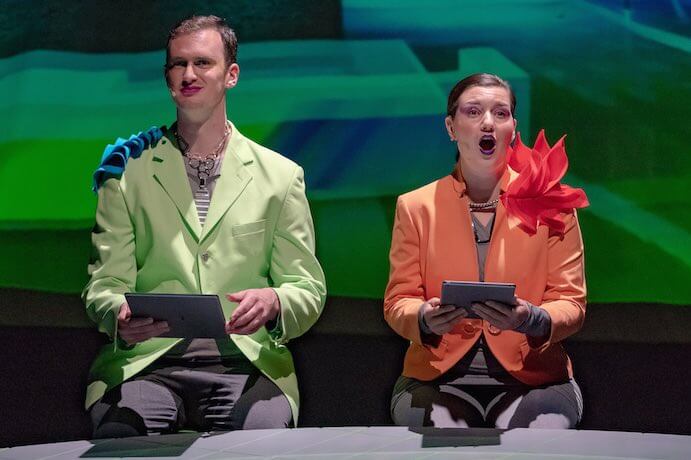Have you seen the #5X5Challenge floating around on social media? Fresh Squeezed Opera’s Executive Director, Jillian Flexner, would like to help you pass the “Name 5 living women composers” part with ease by introducing listeners to their work as well as their names. However, Fresh Squeezed Opera is doing more than producing works solely by women. They’re marking their sixth year of producing, commissioning, and performing new opera for today’s audiences. In this season you’ll find new and historic works that actively examine and celebrate explorations of identity, chance, collaboration, and cultural influences in the 21st century. The giants of our field may be striking out a little too often when it comes to relevancy; but, Flexner and Fresh Squeezed Opera seem ready to mirror Babe Ruth’s called shot.
What is the first thing about an opera that truly grabs your attention and makes you consider programming it?
Programming new opera is particularly challenging. The thing with opera–and the thing that I love most about opera–is its gesamtkunstwerk. Opera isn’t just music, or theater, or set design, or costume design. It encompasses so many aspects of all art. So, when we scour the submissions from a call for scores for something to produce on a fully-staged scale, and all we have to go off is a score, a plot synopsis, and in some cases a recording, it’s very challenging.
What I hope to see in an opera is something that can be collaborative (is the score over-edited with specific stage directions allowing no room for interpretation? Is there a healthy group of artists involved in the orchestration and voice types?), something that can resonate with contemporary audiences, (is the plot overcomplicated? Are the characters relatable?), and something that is inspiring (do I feel emotionally moved or changed? Have I been challenged musically?).

Fresh Squeezed Opera is presenting the world premiere production of American composer Miriam Gideon’s only opera, Fortunato. How has this work gone from partially-legible piano/vocal score to production?
Dr. Stephanie Jensen-Moulton, musicologist and singer, was very interested in the work of composer Miriam Gideon, and discovered an anomaly in her portfolio: an opera, likely formatted for television, that was left in an incomplete state. What Dr. Jensen-Moulton had was a complete piano-vocal score of the work, handwritten, and a fully-realized orchestration of the first act (of a two-act work). Fortunato was never performed during the life of the composer as a completed piano-vocal score, nor was the orchestration of the first act ever realized in a performance: there were no parts to speak of, and no documented attempts at executing the opera, even as a work in progress. For a very practical, performance-driven composer, this was an odd piece: a large scale opera, and one that was written without a commission. Dr. Jensen-Moulton engraved the piano/vocal score, and the orchestrated first act, and published the sheet music through AR Editions.
Fresh Squeezed Opera company member Whitney George’s dissertation/research picks up on her research of Gideon, and aims to do a style study of her specific orchestration techniques (after all, all composers come to the palette of the orchestra differently, and express their music through this same medium in different terms)—and then recreate her style of orchestration to complete the translation from piano-vocal score to fully orchestrated score. The hope is to release the completed score (with a few key corrections) and accompanying parts so that other companies could perform the work in the future.
Whitney George’s piece, “Lost Without You” will be a continuous, surrealist, non-linear narrative from the perspective of women on social media. What are some of the main challenges you face when presenting surrealist or non-linear narrative works to contemporary audiences?
Regardless of how beautiful or innovative a non-linear or surrealist a piece is, it’s a hard sell because you often can’t explain it. This was definitely the case in the last fully-staged show we did, Knot An Opera! by Constantin Basica.
Getting a director with a clear vision for the piece is key. Michael Hofmann, who directed Knot An Opera!, created this amazing through-narrative for the piece, which really didn’t have a plot, and he strung the scenes together with distinct visual motifs. The piece in and of itself was amazing, challenging, and cerebral–that’s why we chose it–but Michael elevated the piece to make it compellingly enigmatic.
With Whitney’s piece, which will be semi-staged, we will develop a clear directorial vision for the performance in collaboration with the musicians and the composer. How they perform the piece is just as enlightening as any scenic design.
But I think what’s especially interesting about presenting surrealist works is that the audience responds so strongly to the pieces. It’s almost that, with no plot or story to hang on to, audiences absorb every note. Our company’s belief is that audiences like to be challenged, and they like things that appeal to them personally. These more abstract works are up for more interpretation, which makes them easily personally appealing.

What do you think it is about Fresh Squeezed Opera’s work that brings your loyal audience members back for production after production, even when they’re unfamiliar with the composer or performers?
This is the question that’s plaguing the classical music world. How do you get butts in seats? Some places will tell you that the genre of opera is dying and young people just aren’t interested. But our audience’s average age is 30, and we’ve never had problems filling houses with young people.
People want to see themselves reflected in the entertainment they seek out. Creating productions and producing operas that are tangible to 21st century audiences is key. Sure, there are universal truths that you can find in Mozart and Verdi–and that’s why those will always be produced. But people want to see shows that they can relate to, whether that’s a story about a Vietnamese-American family trying to hold on to their traditions while assimilating to American culture, a program of vocal-electronic music created and performed by only women, or a show questioning the very nature of identity. People like their art to challenge them–so, ok, challenge accepted.
Finally, Fresh Squeezed Opera simply produces good operas. Our productions are charming, our musicianship is exceptional, and we have fun doing it.
[Tweet “People like their art to challenge them–so, ok, challenge accepted.”]
Do you feel that opera can change hearts and minds when it comes to massively charged topics such as the struggle for equity among various groups of people?
Yes and yes. I think when you get a group of representative people creating opera–women, people of color, or people from underserved communities–to highlight stories that have never been told, it has the power to change the world.
In April, we’re presenting the NYC Premiere of Bound by Huang Ruo and Bao-Long Chu–a new production by Ashley Tata, and co-produced with the Baruch Performing Arts Center. Bound tells the true story of Diane Tran, a girl in Texas who was jailed for truancy in high school after repeated absences because in addition to being an honor-roll student, she also held two jobs to support her family. Her parents were refugees from Vietnam. Her father is out of the picture and her mother deeply suffers from untreated PTSD. Over the course of the opera, Diane is torn between keeping with Vietnamese traditions “family-first” and pursuing the American dream.
Bound is incredibly nuanced, diving into each of its characters and painting a true, complicated picture of the cultural collisions that happen everyday to immigrant families in America. These stories often remain untold–particularly that of second-generation refugees. And with the global refugee crisis worsening, and the accompanying rise in xenophobia, it is more important than ever to tell these stories. But what’s special about opera is that the story, whatever it is, becomes so much more than just a story. It’s now told through a beautiful combination of visual art, drama, and music.
The story becomes accessible beyond its original language–art is a universal language. The music, which combines traditional Vietnamese music with Western music, drives the emotions and accentuates the complexities of the characters. The drama conveys the details of the story. The visuals–set, costumes, projections, ground the story to make it relatable to audiences. All these operatic elements work together to create an impactful, compelling, and enigmatic experience unique to each audience member.
























